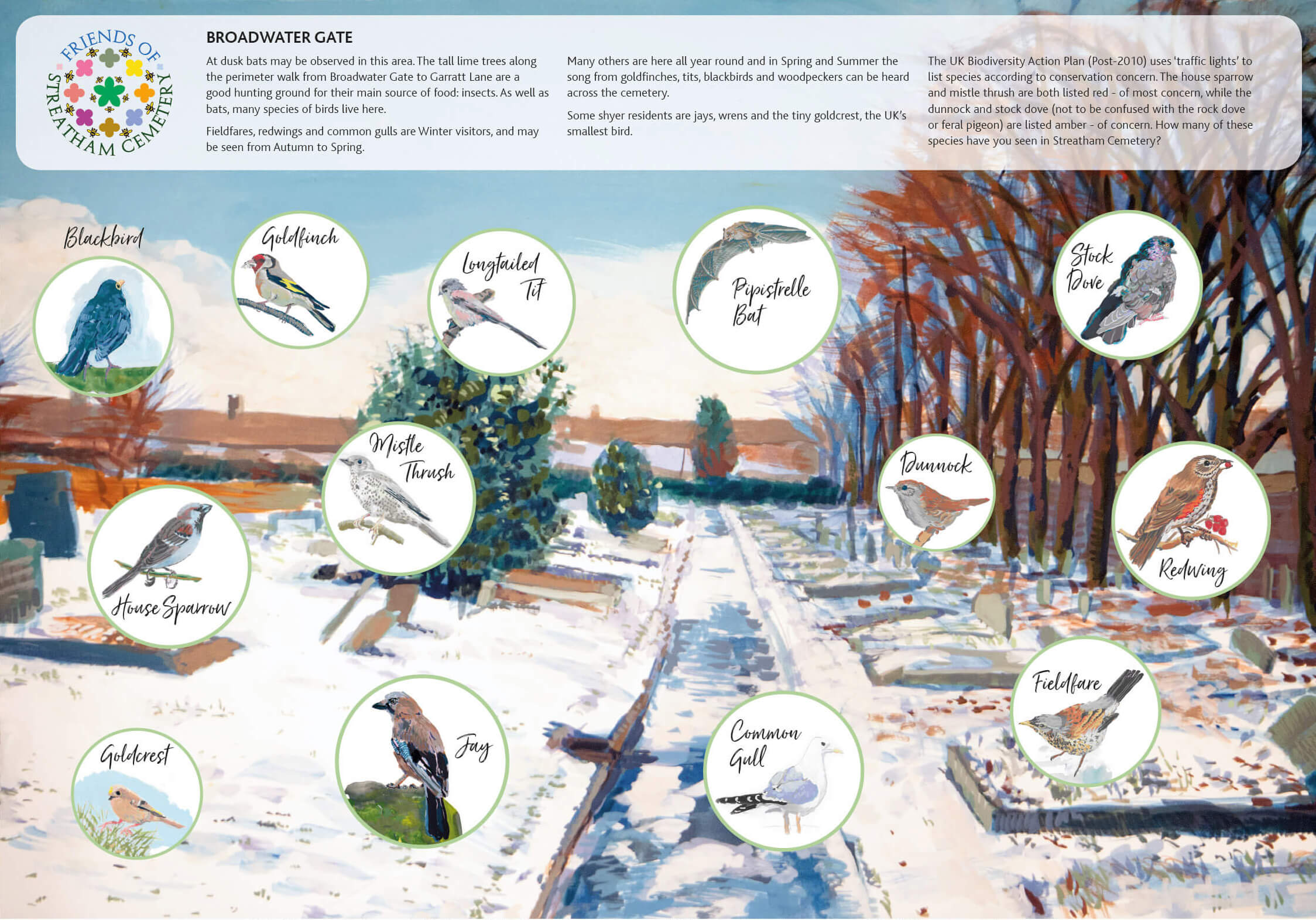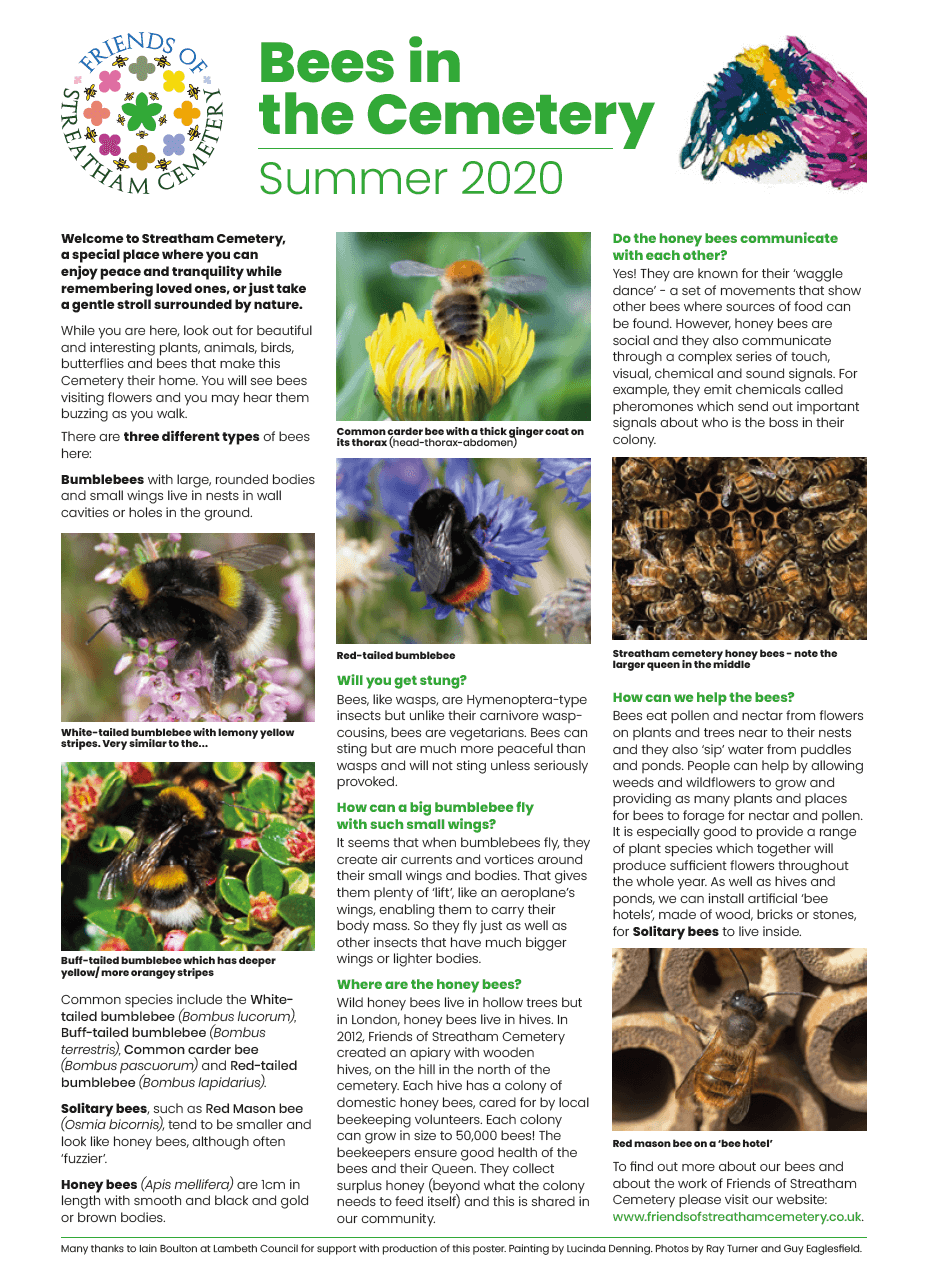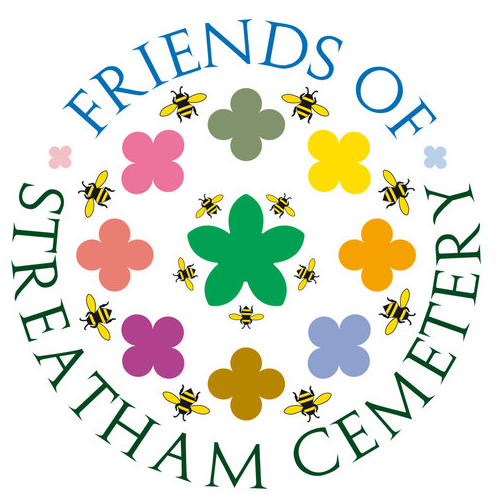Nature
Learn more about the wildlife
at Streatham Cemetary.
at Streatham Cemetary.
At any time of the year you can immerse yourself in nature in Streatham Cemetery where there is plenty of natural beauty to enjoy.
The Friends have installed three information boards showing some of the birds, insects, flowers and fungi that can been seen in the cemetery. One at the Garratt Lane entrance and another at the turning circle at the top of the site near the apiary. The board at the Broadwater Gate (shown below) was sadly vandalised in 2019. We hope to reinstall it in 2023 along with a new board all about trees.
The Friends have installed three information boards showing some of the birds, insects, flowers and fungi that can been seen in the cemetery. One at the Garratt Lane entrance and another at the turning circle at the top of the site near the apiary. The board at the Broadwater Gate (shown below) was sadly vandalised in 2019. We hope to reinstall it in 2023 along with a new board all about trees.

Friends of Streatham Cemetery hope you enhoy this nature board. The Friends would like to thank Lucinda Denning for illustration, Lambeth Council for financial support and Fitzpatrick for manufacture and intallation.
Each year we celebrate nature with a Butterfly Walk in July and a nature table at our Open Day in September along with periodic Bat Walks, Tree Walks and apiary visits. With the help of local experts like Roy Vickery at South London Botanical Institute and Iain Boulton at Lambeth Council we have conducted plant and small mammal surveys. With the help of other experts we hope to conduct fungi and moth surveys.
Bees & Beekeeping
Bees
In the UK there are around 270 species of bee, most of which are solitary bees. Many of these are quite small and lack the distinctive black and yellow stripes associated with honeybees and bumblebees.
In 2020 we produced an information panel (shown below) to look at the more common bees found in the cemetery.
In 2020 we produced an information panel (shown below) to look at the more common bees found in the cemetery.

Beekeeping
The Friends started a community beekeeping group in September 2010. With help from Lambeth Council, an enclosed area for bee hives (an ‘apiary’) was built at the highest point of the cemetery. The first honey bees arrived in May 2011 and they have been resident in the cemetery ever since.
In cold and wet conditions bees cluster inside the hive feeding from their honey stores to survive. As soon as the temperature is 12°C or more, you will see a steady stream of bees leaving the hives to forage for nectar and pollen.
The ‘beekeeping season’ runs from March to September and our beekeepers visit most weeks, typically at 11am on Sunday. If you are interested in joining the beekeeping group (no experience required) please visit then or speak to Guy (tel no. below).
Our apiary has been built at the top of the hill with high posts and fine mesh to ensure flying bees remain above head height and don’t disturb walkers in the cemetery. If you notice damage to the mesh or fence posts, please ring Guy and he will arrange a repair.
Honey from Streatham Cemetery is delicious! A 2019 analysis revealed that it contains nectar from 52 plants. Over half the nectar comes from just three wildflowers: Ribwort Plantain, Yarrow and Crucifer. The cemetery is often carpeted with dandelion lookalikes Autumn Hawkbit and Cat’s Ear but these are only the 13th and 18th most significant. Lime is the most significant tree - hardly surprising given the long rows of Lime trees in the cemetery - but Eucalyptus is next. With only one Eucalyptus tree in the cemetery it is clear our bees travel further afield in search of forage. Hydrangea and Privet appear the most favoured garden plants and Broad Beans are the most significant allotment crop.
We tend to harvest about 20lbs of Spring honey in June and about 40lbs of Summer honey in August. Our honey is sold at two annual events: the Butterfly Walk (around 21 July) and the Open Day (around 21 September). Look out for notices at the gates.
We always encourage new beekeepers. If you would like to get practical beekeeping experience and join our community beekeeping group please contact our head beekeeper, Guy Eaglesfield on 07738 135562.
In cold and wet conditions bees cluster inside the hive feeding from their honey stores to survive. As soon as the temperature is 12°C or more, you will see a steady stream of bees leaving the hives to forage for nectar and pollen.
The ‘beekeeping season’ runs from March to September and our beekeepers visit most weeks, typically at 11am on Sunday. If you are interested in joining the beekeeping group (no experience required) please visit then or speak to Guy (tel no. below).
Our apiary has been built at the top of the hill with high posts and fine mesh to ensure flying bees remain above head height and don’t disturb walkers in the cemetery. If you notice damage to the mesh or fence posts, please ring Guy and he will arrange a repair.
Honey from Streatham Cemetery is delicious! A 2019 analysis revealed that it contains nectar from 52 plants. Over half the nectar comes from just three wildflowers: Ribwort Plantain, Yarrow and Crucifer. The cemetery is often carpeted with dandelion lookalikes Autumn Hawkbit and Cat’s Ear but these are only the 13th and 18th most significant. Lime is the most significant tree - hardly surprising given the long rows of Lime trees in the cemetery - but Eucalyptus is next. With only one Eucalyptus tree in the cemetery it is clear our bees travel further afield in search of forage. Hydrangea and Privet appear the most favoured garden plants and Broad Beans are the most significant allotment crop.
We tend to harvest about 20lbs of Spring honey in June and about 40lbs of Summer honey in August. Our honey is sold at two annual events: the Butterfly Walk (around 21 July) and the Open Day (around 21 September). Look out for notices at the gates.
We always encourage new beekeepers. If you would like to get practical beekeeping experience and join our community beekeeping group please contact our head beekeeper, Guy Eaglesfield on 07738 135562.
Error
Birds
Over 50 different types of bird have been spotted in Streatham Cemetery. Some of these are ‘red’ and ‘amber’ birds as per the UK Biodiversity Action Plan which uses a traffic light system to highlight conservation concerns. Winter visitors like the Fieldfare and Redwing are listed ‘red’. Some birds you might consider very common like Starlings and House Sparrows, are in fact now in steep decline and also listed ‘red’.
For some years now in Spring, Sparrowhawks have nested in the tall Cypress trees in the circle between the two Chapel buildings. Their presence might explain the initial difficulty in spotting small garden birds like sparrows, tits and robins. Most visitors tend to spot the larger birds: crows, jays, magpies and green woodpeckers but, as the pictures below show, patience and observation can lead you to find many interesting small birds. Who knows, in Spring or Autumn you might even spot a migrating visitor like a Pheasant or Ring Ouzel - both of which have been seen, albeit very rarely.
For some years now in Spring, Sparrowhawks have nested in the tall Cypress trees in the circle between the two Chapel buildings. Their presence might explain the initial difficulty in spotting small garden birds like sparrows, tits and robins. Most visitors tend to spot the larger birds: crows, jays, magpies and green woodpeckers but, as the pictures below show, patience and observation can lead you to find many interesting small birds. Who knows, in Spring or Autumn you might even spot a migrating visitor like a Pheasant or Ring Ouzel - both of which have been seen, albeit very rarely.
All pictures by Ray Turner.
Error
Butterflies and Moths
The Marbled White prefers long grass and it seems that the policy of keeping designated areas of long grass is helping it to thrive. The area around the apiary is always kept long and is a good place to spot these.
Apart from spotting the distinctive Burnet Moth and Jersey Tiger Moth very little is known about the moths which might inhabit the cemetery. The Friends are hoping to arrange a moth trapping exercise in 2022 to increase our knowledge of what species are present.
Apart from spotting the distinctive Burnet Moth and Jersey Tiger Moth very little is known about the moths which might inhabit the cemetery. The Friends are hoping to arrange a moth trapping exercise in 2022 to increase our knowledge of what species are present.
Below is a list of the 19 butterflies which have been spotted in Streatham Cemetery.
- Small White
- Green-veined White
- Large White
- Orange Tip
- Brimstone
- Peacock
- Comma
- Marbled White
- Painted Lady
- Red Admiral
- Small Tortoiseshell
- Speckled Wood
- Small Copper
- Meadow Brown
- Common Blue
- Holly Blue
- Essex Skipper
- Small Skipper
- Large Skipper
Error
Error
Trees
The cemetery has over 125 trees. Many of the larger trees near the main gate on Garratt Lane were no doubt planted in the 1880s/1890s when the site was being prepared as a cemetery. Previously much of the site had been nursery gardens, largely owned by Peter Barr, the ‘Daffodil King’ - recently celebrated by local historian Geoff Simmons.
Some of the more exotic trees are the Indian Bean Tree or Catalpa, the Japanese Pagoda Tree and the Gingko or Maidenhair Tree.
Some of the more exotic trees are the Indian Bean Tree or Catalpa, the Japanese Pagoda Tree and the Gingko or Maidenhair Tree.
Error
Wildflowers
As the year progresses the cemetery is carpeted by a succession of wildflowers and grasses. Some of these last just a few days. All of them are valuable sources of pollen and nectar for insects. The most important flowers for the honeybees in the cemetery are Ribwort Plantain and Yarrow shown here.
Between 2009-2013 John Hughes and Roy Vickery from the South London Botanical Institute made several visits to develop a plant list for the cemetery which you can find here.
Error
Other Wildlife
The Friends encourage use of the cemetery for gentle recreation and enjoying nature. At our events we tend to focus on bees, butterflies, trees and wildflowers. There are of course many other types of flora and fauna.
Visitors will easily spot larger mammals like squirrels and foxes. By contrast, voles and mice are never seen! After winter, our beekeepers sometimes find mice nests inside the beehives. A warm, dry location - albeit a dangerous one - for a bee sting can easily kill a mouse.
Insect life includes some impressive dragonflies like hawkers and skimmers as well as many interesting types of hoverfly and wasp. Beyond the black and yellow wasp we tend to be wary of at picnics, there are 7,000 other varieties in the UK compared to just 250 varieties of bee.
Visitors will easily spot larger mammals like squirrels and foxes. By contrast, voles and mice are never seen! After winter, our beekeepers sometimes find mice nests inside the beehives. A warm, dry location - albeit a dangerous one - for a bee sting can easily kill a mouse.
Insect life includes some impressive dragonflies like hawkers and skimmers as well as many interesting types of hoverfly and wasp. Beyond the black and yellow wasp we tend to be wary of at picnics, there are 7,000 other varieties in the UK compared to just 250 varieties of bee.

















































